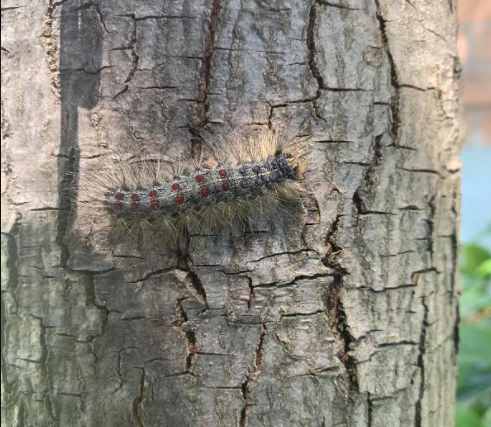Clipping the gypsy moths’ wings is in the works for 2022.
Barrie councillors gave initial approval to a motion Monday night to have city staff investigate the feasibility of aerial spraying or the use of pheromone traps to help prevent future gypsy moth infestations, including in bordering woods and on greenspaces, along with costs, and report back as part of next year’s budget process.
“Although we are probably in the worst year of a 10-year cycle, everyone’s asking about it, everyone’s talking about it,” Mayor Jeff Lehman said of the gypsy moths.
“I’m getting reports of sidewalks and driveways that are getting slippery, decks a mess,” said Coun. Clare Riepma, who represents Ward 1 in the city's east end.
“We have bordering areas, in particular Nicklaus Drive in Ward 3, that boundaries on Springwater (Township), is raining caterpillars,” said Coun. Ann-Marie Kungl.
City council will consider final approval of this motion at its June 28 meeting.
Gypsy moths are invasive bugs which feed on tree leaves, destroying tree growth and taking away trees’ ability to produce new leaves. The city’s urban forestry page says the gypsy moths prefer oak, birch, aspen, sugar maple, American beech, eastern white pine and Colorado blue spruce trees.
The caterpillars can not only strip trees bare of their leaves, but leave a nasty rash on people’s skin, as their hairs are an irritant.
The gypsy moth was brought to North America in the 1860s from Europe and spread to Ontario about 100 years later.
Living Green has told BarrieToday it anticipates Simcoe County trees will be severely affected this year. The European gypsy moth has a seven- to 10-year cycle and this year is expected to see a peak in its population.
Councillors asked city staff Monday what can be done now, especially with boulevard trees.
Dave Friary, Barrie’s director of operations, says the city doesn’t have enough staff to look after each tree, although it is creating a hot-spots map for chemical treatment.
“The stage that we’re in right now, the recommendation is to wrap your trees in burlap,” he said. “They’re the larger caterpillars. What they’ll do is sort of nest inside the burlap, because of the warmth, and then you simply remove the burlap, soak it in soapy water.”
Coun. Robert Thomson asked what could be done with city surfaces.
“Sidewalks are becoming extremely slippery, and dirty and roads are the same,” he said.
Friary said the city has had street sweepers out in Letitia Heights area. Barrie has one small sidewalk sweeper, but it’s for the downtown, and the city’s five other sidewalk sweepers are all in for service, following the winter. He noted Barrie has 600 kilometres of sidewalk.
The city has also been chemically treating some of the larger oak trees in Sunnidale and Kearsey parks, Friary said.
“We are doing everything the province has recommended to fight the gypsy moths, other than the aerial spraying,” he said.
As for next year, councillors will have some choices to make.
Andrea Miller, Barrie’s general manager of infrastructure and growth management, says one approach would spraying the city’s own woodlots and not the residential areas.
“If council’s intention is you do want to go into residential areas, that is obviously going to be a very different approach… obviously much more costly,” she said. “Certainly there will need to be some consultation (with Barrie’s neighbours) because it is a pesticide we would need to be using.”
As for pheromone traps, they are baited with a synthetic lure which mimics the pheromone released by the female gypsy moth to attract the male. When males enter the trap looking for a female producing the pheromone, they get stuck. But most see pheromone traps as a way of determining the extent of the gypsy moth problem, rather than a solution.
For more information, visit ontario.ca/page/gypsy-moth.



